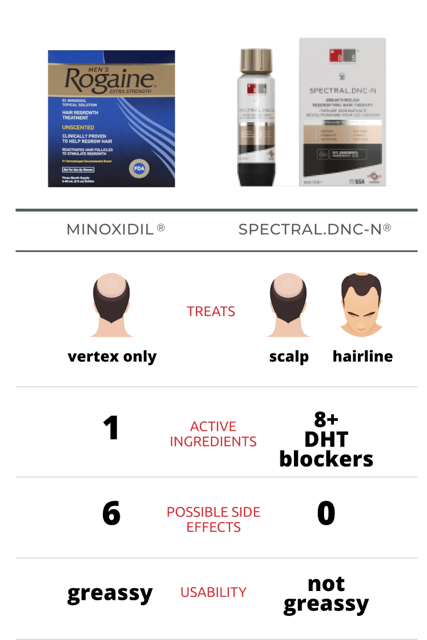Minoxidil is a common ingredient in hair loss treatments. It is the generic name for Rogaine and popularly used by many men and women who want to keep a full head of hair. However, a lot of people misunderstand what minoxidil does. Is it capable of preventing the mechanisms of hair loss? Is it just a superficial treatment?
What Is Minoxidil?
Minoxidil is a vasodilator. That means that, when it is applied to your scalp, it helps open up the blood vessels and promote blood flow to the hair follicles. In turn, this ensures that the follicles are getting more oxygen and nutrients. This process has been clinically proven to promote hair growth.
Typically, minoxidil is used for male and female pattern baldness, also called androgenetic alopecia. It is often available as a foam or solution that can be applied directly to the scalp.
Although minoxidil is known to increase hair growth, it is not without side effects. The most common of these are burning, stinging or redness near where it was applied. More serious side effects include dizziness, fast heartbeat, chest pain, weight gain and trouble breathing. However, these more significant side effects are very uncommon.
Like many other medications, minoxidil was originally invented to treat a completely different problem. Rather than a hair loss treatment, it was a blood pressure medication. This may be part of the reason that it can have some significant side effects.
What Is DHT?
Dihydrotestosterone is a hormone that is believed to cause hair loss. It is formed when there is an excess of free testosterone in the body. An enzyme called 5 alpha-reductase helps the process of transforming testosterone to DHT.
DHT appears to cause hair follicles to shrink. As they shrink, the hair shafts get thinner and less healthy. Eventually, this will cause the hair to fall out. Once the hair falls out, the nutrient supply to the empty follicle will slow. This can cause the follicle to stop producing new hair.
Shop DS Laboratories Minoxidil
Is Minoxidil a DHT Blocker?
No, minoxidil is not a DHT blocker. It can stimulate new hair growth by encouraging the blood vessel in the scalp to deliver nutrients to the affected follicles. However, it does not prevent DHT from reaching the follicles.
This does not mean that minoxidil is an ineffective treatment for hair loss. It can help to keep the hair follicles healthier for longer, so they keep producing hairs. However, it is not combatting the key mechanism that causes androgenetic hair loss. Therefore, some people prefer to combine minoxidil with other treatments that can block DHT.
Is There a Better Option?
Yes, there are several better options than minoxidil. While this substance was one of the earliest effective medications for hair loss, the science has improved a lot since minoxidil was first invented.
DHT Blockers
Several active ingredients in other hair loss treatments can effectively block DHT and help combat androgenetic hair loss. For example, ketoconazole is clinically proven to fight the conversion of testosterone into DHT. It also helps prevent fungal colonization around hair follicles that can also cause hair loss.
Caffeine is also effective in combatting DHT. Studies suggest that is can reverse the effects of DHT on hair follicles. It simultaneously improves blood circulation to the scalp.
Both compounds are used in Revita Shampoo and Conditioner. This treatment combined DHT-blocking ingredients with others that stimulate new hair growth. Additionally, it is all delivered with a nanosome delivery system. Clinical tests show that Revita Shampoo and Revita Conditions decrease hair loss, improve the growth of new hairs and improve the overall appearance of hair.
Azelaic acid is another effective DHT treatment. It inhibits the 5 alpha-reductase enzyme that converts testosterone into DHT. In doing so, it helps to lower the amount of DHT in the scalp and prevent hair loss.
This compound is one of the active ingredients in Spectral.DNC-N. However, the star of that treatment is another ingredient: Nanoxidil.
Nanoxidil
Nanoxidil is a vasodilator like minoxidil. However, it has a lower molecular weight and improved efficacy. It also has no known side effects, unlike minoxidil. In other words, it is a significant improvement over the older treatment.
By opening up ion channels in the scalp, Nanoxidil helps deliver nutrients and oxygen to the follicles. This also helps to prolong the anagen phase of the follicle, improving hair growth.
As mentioned above, this clinically proven ingredient is included in Spectral.DNC-N. This topical treatment has been shown in repeated studies to effectively suppress DHT, prevent perifollicular fibrosis, prolong the anagen phase, increase the vascular endothelial growth factor and otherwise treat hair follicles.
In other words, Spectral.DNC-N is a comprehensive treatment for hair loss. It both fights the mechanisms of hair loss while promoting healthier hair growth. Patients who are dissatisfied with minoxidil should consider making the switch.

